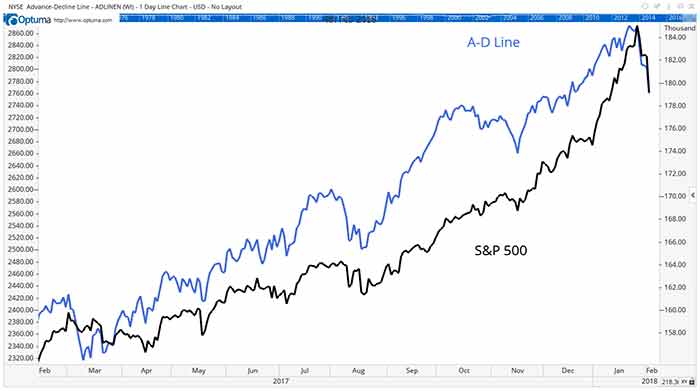…Many of us think Wall Street is using sophisticated tools to make money. It is…but big Wall Street firms also use simple tools to make money…One tool many large firms use is the advance-decline line.
The original article by Matt Badiali has been edited here for length (…) and clarity ([ ]) by munKNEE.com to provide a fast & easy read.
The Advance-Decline Line
…The advance-decline line indicator subtracts the number of stocks that closed down every day (declines) from the number that closed up (advances). The A-D line is the blue line in the charts below. The S&P 500 Index is the black line.

The above four charts show the market action before significant declines. In each case, the A-D line (the blue line) was in a downtrend before the S&P 500 turned lower. This happened before bear markets that led to losses of 50% or more in 1972, 1999 and 2007. It also happened before the 1987 crash.
The A-D line simply counts how many stocks are going up. In a bull market, we expect most stocks to be going up. In a bear market, the majority of stocks should be going down. That is a simple idea, but, as the charts show, it’s an important indicator to follow.
Near market tops, we see fewer stocks going up. The index is moving up because just a few large stocks are producing gains.
- In 2007, housing stocks and financials were still moving up after most stocks peaked.
- In 1999, internet stocks were the market leaders while most stocks were in downtrends.
- In 1987, traders were buying just the largest stocks for a strategy called portfolio insurance. That insurance failed spectacularly in October.
- In 1972, the Nifty Fifty became popular, and investment managers bought just the 50 largest companies.
Narrow buying always leads to a sell-off. That means we should watch the A-D line for an advance warning signal of the next bear market.
The next chart shows the indicator right now.

Conclusion
The S&P 500 and the Advance-Decline line are in synch. As long as they remain in synch, a bear market is unlikely. We might see a pullback, which is a decline of 5% to 10% but that will be a chance to buy more stocks and prepare for the next upturn.
Related Articles From the munKNEE Vault:
1. Ride the Market Waves With These 6 Momentum Indicators
It is hard to know what to buy or sell let alone just when to prudently do so. Thank goodness there are indicators available that provide information of stock and index movement of a more immediate nature to help you make such important decisions. This article describes the 6 most popular Momentum Indicators. If ever there was a “cut and save” investment advisory this is it!
2. Yes, You Can Time the Market – Use These Trend Indicators
Remember, the trend is your friend and now you have an arsenal of such indicators to make an extensive and in-depth assessment of whether you should be buying or selling. If ever there was a “cut and save” investment advisory this article is it.
3. Make Money! Time the Market Using Market Strength Indicators- Here’s How
There are many indicators available that provide information on stock and index movement to help you time the market and make money. Market strength and volatility are two such categories of indicators and a description of six of them are described in this “cut and save” article. Read on!
4. Should Technical Analysis Be Ignored? We Think So – Here’s Why
The Web is crawling with technical analysis (TA)…[and,] given its popularity, [begs the questions as to whether or not there] really is something to it. [Based on our research,] the short answer is no, not really, at least not in developed markets like the US or the UK… Furthermore, most of the popular TA indicators that are bandied around are nonsense jargon and should be ignored as useless noise. [Let us explain our position.]
Research has found that investors using technical analysis had some performance advantage over those who didn’t use these methods. The research also found that the performance advantage was more evident during down markets. If that has piqued your interest, read on to learn more about a few of the more popular types of technical analysis.
6. Use the “Graham Formula” To Determine the Fair Price of a Stock – Here’s How
Knowing how to properly value a stock is probably the most important skill for a value investor to develop and over the last fifty years one of the most popular methods to discover the fair price of a stock has been the Benjamin Graham formula.
7. Technically Speaking: What Exactly Is “RSI?”
Exactly what is RSI and how is it calculated?
8. Dogs of the Dow: A Simple Strategy Using the Dividend Yield
Investing in the Dogs of the Dow, which refers to the 10 highest-yielding stocks in the Dow Jones Industrial Average at the end of the year, is a very simple strategy you can use in 2018 to beat the market. Here’s everything you need to know.
9. Use Return on Equity (ROE) To Better Evaluate the Potential Returns Of A Company’s Stock
Brokers and portfolio managers often speak in what seems like a foreign language. They often use abbreviations to make the investment process seem more complicated than it truly is. This week, we will examine one of these abbreviations, Return on Equity, (ROE) that is used to evaluate the potential returns of a company’s stock.
 munKNEE.com Your Key to Making Money
munKNEE.com Your Key to Making Money